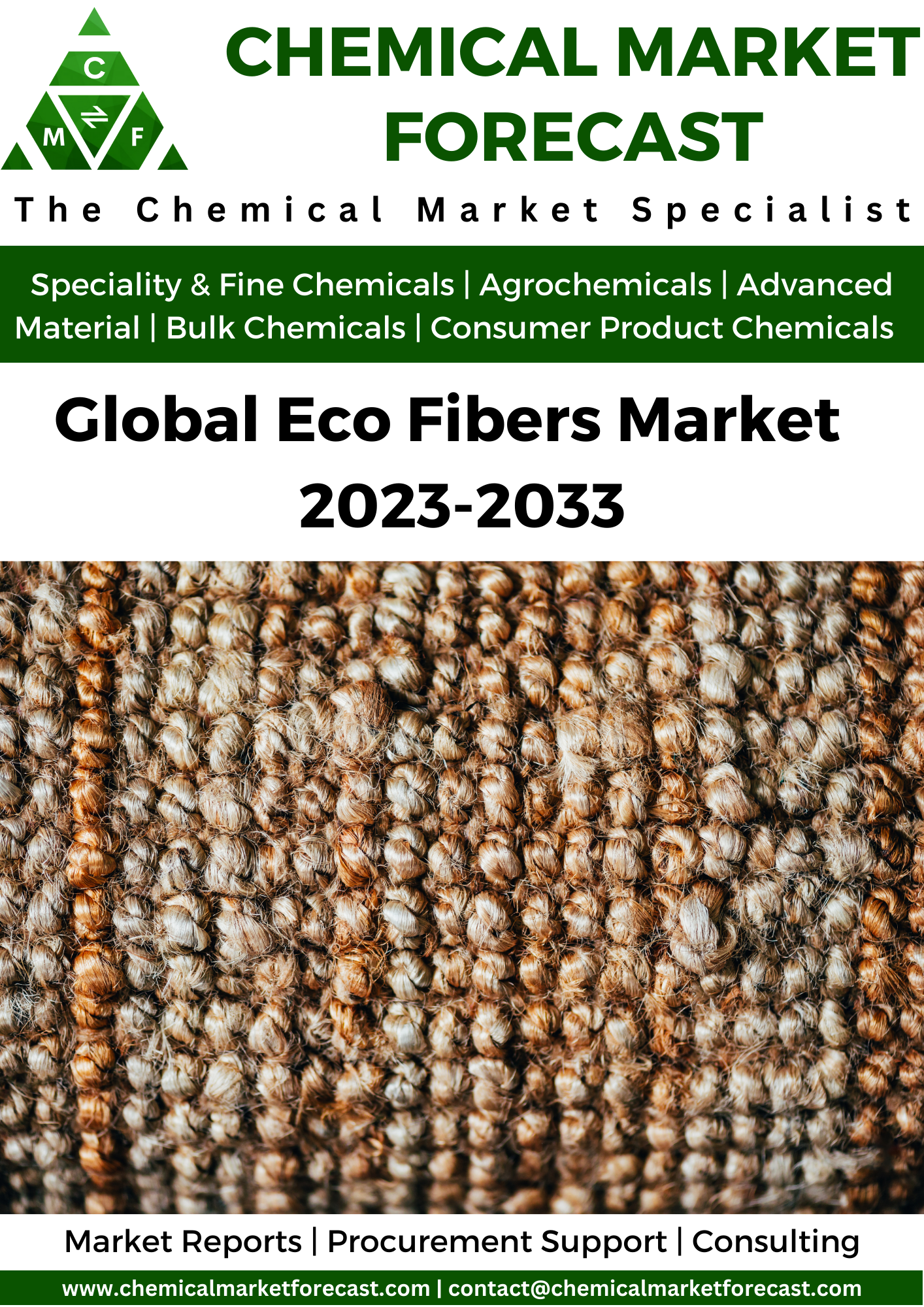Global Eco Fibers Market
This report is aimed to provide a clear and in-depth analysis of the industry dynamics, current & past trends, market size, segmentation and competitive landscape of the Global Eco Fiber Market. The report also covers various other key aspects like company profiles, segmentation analysis by type.
Cotton fibre, for example, is free of impurities when no harmful pesticides or insecticides are used in its cultivation. If this is the case, it is environmentally friendly. Even if they are produced without any of these harmful substances, they can become ‘polluted’ when processed for yarns and fabrics due to all of the textile chemicals that are used on them. The same is true for animal fibres such as wool, which can become contaminated due to pesticides used in sheep dips or a variety of drugs used to treat animal diseases. However, only when the plant fibre, for example, cotton, is grown without the use of harmful pesticides and with the aid of composted manures and cover crops can it be labelled “organic.”
The textile industry has numerous working procedures that combine to form flow processes. Each process has a different impact on the environment and human health. As a result, many eco-friendly fibres have been developed that do not require the use of pesticides or chemicals, such as bamboo, hemp, Ramie, mud silk, and so on.
Natural fibres are derived from plants (such as cotton, hemp, jute, and so on), animals (such as wool, fur, and so on), or insects (such as silk). Man-made fibres are classified into two types: synthetic fibres and regenerated fibres. Synthetic fibres are entirely composed of chemicals such as polyester fibre or nylon fibre. Natural polymers are transformed into regenerated fibres using a chemical-based process.
These fibres are divided into two types: those derived from proteins and those derived from cellulose. Protein-derived regenerated fibres are derived from plant proteins such as corn, soy, peanut, and so on, or from animal proteins such as casein from milk. Regenerated cellulose fibres are made from the cellulose of wood pulp or leaves.
Bamboo, rayon, lyocell, and tencel are examples of such fibres. As a result, these man-made regenerated fibres (some of which are sometimes referred to as synthetic fibres, such as rayon) are also eco-friendly fibres.
There are many suppliers of eco fibers, both online and offline, who offer a range of sustainable textiles for various applications. Some of the popular suppliers include, Patagonia, a clothing company that uses organic cotton, recycled polyester, and other eco fibers in their products. Hemp Traders, a company that specializes in hemp products, including clothing and textiles made from hemp fibers. Ecovative Design, a company that produces eco-friendly packaging materials and textiles made from mushrooms and agricultural waste. Lenzing Group, a leading producer of Tencel (lyocell) and Modal (rayon) eco fibers. Bambrotex, a company that produces bamboo-based textiles and fabrics
TABLE OF CONTENT
Global Eco Fibers Market Report
1 Market Introduction of Global Eco Fibers Market Report
2 Market Segmentation of Eco Fibers Market Report
2.1 Eco Fibers Market Segmentation By Region
2.2 Eco Fibers Market Segmentation By Type
2.3 Eco Fibers Market Segmentation By Crop Type
3 Cost Structure of Global Eco Fibers Market Report
4 Country Analysis of Global Eco Fibers Market Report
4.1 China
4.1.1 Eco Fibers Market Size in China
4.1.2 Eco Fibers Market Trends & Analysis in China
4.1.3 Key Eco Fibers companies in China
4.1.4 Regulatory Framework of Eco Fibers Market in China
4.2 Germany
4.2.1 Eco Fibers Market Size in Germany
4.2.2 Eco Fibers Market Trends & Analysis in Germany
4.2.3 Key Eco Fibers companies in Germany
4.2.4 Regulatory Framework of Eco Fibers Market in Germany
4.3 France
4.3.1 Eco Fibers Market Size in France
4.3.2 Eco Fibers Market Trends & Analysis in France
4.3.3 Key Eco Fibers companies in France
4.3.4 Regulatory Framework of Eco Fibers Market in France
4.4 Italy
4.4.1 Eco Fibers Market Size in Italy
4.4.2 Eco Fibers Market Trends & Analysis in Italy
4.4.3 Key Eco Fibers companies in Italy
4.4.4 Regulatory Framework of Eco Fibers Market in Italy
4.5 Netherland
4.5.1 Eco Fibers Market Size in Netherland
4.5.2 Eco Fibers Market Trends & Analysis in Netherland
4.5.3 Key Eco Fibers companies in Netherland
4.5.4 Regulatory Framework of Eco Fibers Market in Netherland
4.6 Russia
4.6.1 Eco Fibers Market Size in Russia
4.6.2 Eco Fibers Market Trends & Analysis in Russia
4.6.3 Key Eco Fibers companies in Russia
4.6.4 Regulatory Framework of Eco Fibers Market in Russia
4.7 Canada
4.7.1 Eco Fibers Market Size in Canada
4.7.2 Eco Fibers Market Trends & Analysis in Canada
4.7.3 Key Eco Fibers companies in Canada
4.7.4 Regulatory Framework of Eco Fibers Market in Canada
4.8 Mexico
4.8.1 Eco Fibers Market Size in Mexico
4.8.2 Eco Fibers Market Trends & Analysis in Mexico
4.8.3 Key Eco Fibers companies in Mexico
4.8.4 Regulatory Framework of Eco Fibers Market in Mexico
4.9 Singapore
4.9.1 Eco Fibers Market Size in Singapore
4.9.2 Eco Fibers Market Trends & Analysis in Singapore
4.9.3 Key Eco Fibers companies in Singapore
4.9.4 Regulatory Framework of Eco Fibers Market in Singapore
4.10 United Kingdom
4.10.1 Eco Fibers Market Size in United Kingdom
4.10.2 Eco Fibers Market Trends & Analysis in United Kingdom
4.10.3 Key Eco Fibers companies in United Kingdom
4.10.4 Regulatory Framework of Eco Fibers Market in United Kingdom
4.11 Switzerland
4.11.1 Market Size in Switzerland
4.11.2 Market Trends & Analysis in Switzerland
4.11.3 Key Eco Fibers companies in Switzerland
4.11.4 Regulatory Framework of Eco Fibers Market in Switzerland
4.12 Brazil
4.12.1 Market Size in Brazil
4.12.2 Market Trends & Analysis in Brazil
4.12.3 Key Eco Fibers companies in Brazil
4.12.4 Regulatory Framework of Eco Fibers Market in Brazil
4.13 USA
4.13.1 Market Size in US
4.13.2 Market Trends & Analysis in US
4.13.3 Key Eco Fibers companies in US
4.13.4 Regulatory Framework of Eco Fibers Market in US
4.14 Japan
4.14.1 Market Size in Japan
4.14.2 Market Trends & Analysis in Japan
4.14.3 Key Eco Fibers companies in Japan
4.14.4 Regulatory Framework of Eco Fibers Market in Japan
4.15 South Korea
4.15.1 Market Size in South Korea
4.15.2 Market Trends & Analysis in South Korea
4.15.3 Key Eco Fibers companies in South Korea
4.15.4 Regulatory Framework of Eco Fibers Market in South Korea
4.16 India
4.16.1 Market Size in India
4.16.2 Market Trends & Analysis in India
4.16.3 Key Eco Fibers companies in India
4.16.4 Regulatory Framework of Eco Fibers Market in India
4.17 Thailand
4.17.1 Market Size in Thailand
4.17.2 Market Trends & Analysis in Thailand
4.17.3 Key Eco Fibers companies in Thailand
4.17.4 Regulatory Framework of Eco Fibers Market in Thailand
4.18 Russia
4.18.1 Market Size in Russia
4.18.2 Market Trends & Analysis in Russia
4.18.3 Key Eco Fibers companies in Russia
4.18.4 Regulatory Framework of Eco Fibers Market in Russia
4.19 Malaysia
4.19.1 Market Size in Malaysia
4.19.2 Market Trends & Analysis in Malaysia
4.19.3 Key Eco Fibers companies in Malaysia
4.19.4 Regulatory Framework of Eco Fibers Market in Malaysia
4.20 Saudi Arabia
4.20.1 Market Size in Saudi Arabia
4.20.2 Market Trends & Analysis in Saudi Arabia
4.20.3 Key Eco Fibers companies in Saudi Arabia
4.20.4 Regulatory Framework of Eco Fibers Market in Saudi Arabia
5 Eco Fibers Market Trends
5.1 Eco Fibers Market Trends- Key Drivers
5.2 Eco Fibers Market Trends- Key Restraints
5.3 Eco Fibers Market Trends- Key Challenges
5.4 Porter’s Five Forces Analysis of Eco Fibers Market
5.5 PEST Analysis- Eco Fibers Market
6 Eco Fibers Market Forecast
6.1 Eco Fibers Market Forecast By Region
6.1.1 North America
6.1.2 Europe
6.1.3 APAC
6.1.4 Middle East
6.1.5 ROW
6.2 Eco Fibers Market Forecast By Type
6.2.1 Fertilizer
6.2.2 Pesticide
6.3 Eco Fibers Market Forecast By Crop Type
6.3.1 Fruits & Vegetables
6.3.2 Oilseed and Pulses
6.3.3 Cereals & Grains
6.3.4 Other
7 Supply Chain of the Eco Fibers Market Analysis
8 Opportunity Analysis
9 Scenario Analysis
10 Key Company Profiles
11 Strategic Conclusions – Eco Fibers Market Report
12 Abbreviations used in Eco Fibers Market Report






Reviews
There are no reviews yet.